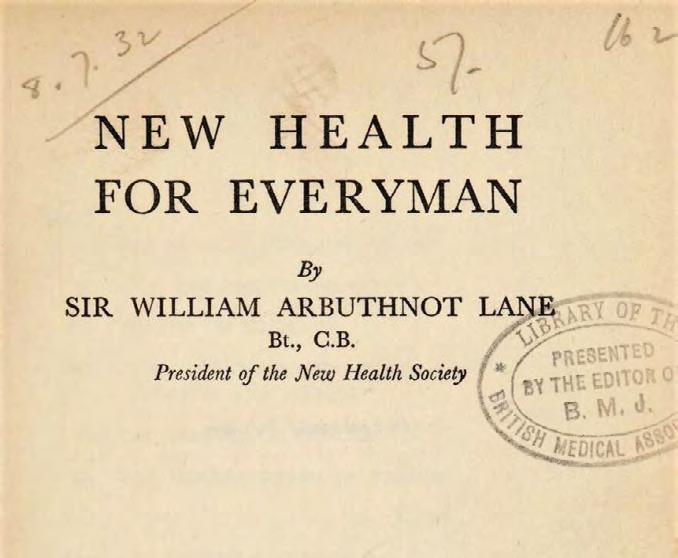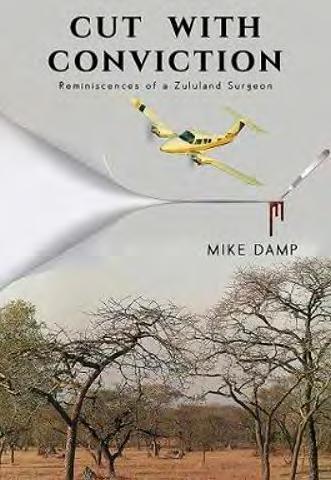
6 minute read
Sir William Arbuthnot Lane (1856-1943)
Surgical innovator: health educator Bt. C.B. MB BS (London) FRCSMS Hon. FACS
Sir William Arbuthnot Lane appeared in Vanity Fair on 31 May 1913, with the magazine noting, ‘in these days it is well to note that Mr Lane comes honestly by his honours. He is the eldest son of a Brigade-Surgeon for one thing. He is known as the great exponent of the operative treatment of fracture by plating for another.
Advertisement
‘Great as is Mr Lane’s prestige among the Britishers, he is even perhaps as well known in America. These strange people admire his type of surgery. It is so skilful and wise and daring. It is “like the pies Mother made.”’ William Arbuthnot Lane was born on 4 July 1856 at Fort George, near Inverness, Scotland, the eldest of the three sons and four daughters of Benjamin Lane, assistant surgeon, 80th Regiment of Foot. His family always called him Willie, and thus the title of his Vanity Fair portrait was provided. As the family followed its army regiment, young William attended schools in eight countries on four continents before he was sent to school at Stanley House, Bridge of Allan, in Scotland. He matriculated at Edinburgh University and then decided to follow his forebears in the study of medicine. His father, being then stationed at Woolwich, entered William as a student at Guy’s Hospital in October 1872. The hospital, which was close to London Bridge Station, allowed for easy commuting. This was the beginning of Lane’s long association with Guy’s Hospital: his earlier ambition to be a physician was replaced with surgery as he was more likely to find a vacancy sooner on the surgical rather than the medical side at Guy’s. He qualified as a Member of the Royal College of Surgeons (RCS) in 1877. Lane was then advised to take a London degree, which involved retracing his steps, beginning with matriculation. He did well, gaining the gold medal in Anatomy at the intermediate examination and the Gold Medal in Medicine at the final examination in 1881. The following year, he became a Fellow of the RCS and in 1883 proceeded to his M.S. He was then appointed assistant surgeon to the Hospital for Sick Children, Great Ormond Street, and five years later, at 32, was elected assistant surgeon to Guy’s Hospital. He worked there until he retired in 1920.
Lane’s appointment to Guy’s was preceded by six years there as a demonstrator of Anatomy, where he revealed his skills of observation, initially with skeletal changes resulting from occupations – changes in bones, cartilages and joints due to occupational posture, pressure, and strain. He subsequently wrote papers on ‘The anatomy of the charwoman’ and ‘The anatomy of the shoemaker’. Lane preferred to work with his own methods rather than accept standard practice. It was in 1883 that he began writing on fractures and he concluded in the early 1890s that splints were likely to produce permanent injury and that for intractable fractures open reduction with rigid fixation was necessary. Lane began operating on fractures from 1892, insisting on the most scrupulous asepsis. He introduced the ‘no touch’ technique, thus pioneering aseptic surgery and advancing beyond antiseptic surgery. He introduced sterile caps, masks and gowns in 1900, collaborating with Down Brothers to design instruments for this new form of surgery, in which no part of an instrument that entered the wound was to make contact with the surgeon’s hand. Accused of turning simple fractures into compound, Lane insisted that the surgeon do as neat a job ‘when repairing broken bones as a cabinet maker mending the legs of broken chairs’. The frontispiece of his surgical text, published in 1913, reveals the incredible breadth of Lane’s surgical procedures: he improved whatever he touched. His innovations included the removal of a portion of a rib when treating empyema in a child, an operation for cleft palate early in life, and plating fractured long bones to obtain perfect apposition. Lane exhibited imperturbable calm at any difficulties encountered during operations. He fascinated his assistants with his extraordinary dexterity and became renowned on both sides of the Atlantic as the only surgeon the Americans travelled to visit in London. He operated on socialites, politicians, and royalty – the latter inevitably leading to his baronetcy in 1913. Lane joined the Royal Army Medical Corps on its formation and, during the war of 1914-18, organised the Queen’s Hospital at Sidcup for the treatment of facial injuries, where Harold Gillies and Henry Tonks laid the foundations of modern plastic surgery. For this Lane
was appointed Companion of the Most Honourable Order of the Bath (CB). He had a successful private practice generating an income of £20,000 per annum by the early 1920s. Contemporary newspapers described him as ‘the bestknown surgeon in Britain’. Lane gained a high social position, as distinct from institutional influence. He did serve on the Council of the RCS from 1908 to 1916; however, he was never interested in examining – attending societies to preach rather than exchange opinions. A bibliography of his published writings 1883-1938 was privately printed in 1938, listing almost 400 entries. The last phase of his career began when, using his position, he founded the New Health Society in 1925, a private charity, to spread popular health education throughout the country. Active from 1926-1937, the society’s motto was ‘prevention rather than cure’. Once again, he was a pioneer. His views were frowned upon by the medical profession, particularly by the British Medical Association (BMA).
Lyons Tea Shops in England were then at the peak of their popularity; the chain opened a Vita-Sun Café at which health foods were available and their vitamin content rated on the menu. Lane provided articles such as ‘The Athlete’s Diet’, which were printed on these menus. He also wrote many similar articles for the Daily Mail.
This was seen by some, particularly by the BMA and the General Medical Council (GMC), as a form of indirect advertising. To avoid litigation, Lane resigned from the BMA, remaining in practice at his home, where he was registered with the GMC until November 1932, when he voluntarily ceased to practise. He became obsessed with the danger to general health caused by chronic constipation and he commenced operating on the large intestine with short-circuit procedures that came to be known as ‘Lane’s operation’. His entry in the Dictionary of National Biography (DNB) includes the tag, ‘Sir Arbuthnot Lane, colon, semi-colon, full-stop.’ In his text, New Health for Everyman, he set out his ‘10 golden health rules’, which to the modern eye appear eminently reasonable. Eat meat only in moderation, include in your daily diet wholemeal bread and citrus fruit, drink at least six tumblers of water a day, work/sleep in well aired rooms, and exercise night and morning for 10 minutes. Lane himself walked four miles every day, wet or fine. He was tall, rather thin and with a distinguished bearing; he seemingly aged slowly. Although he enjoyed controversy he was a kindly and genial man, much beloved by his friends. Lane married Charlotte Briscoe of Tinvane House, Co. Kilkenny, on 25 October 1884. She bore him three daughters and a son, who succeeded as second baronet. Lady Lane died in April 1935, six months after their golden (50th) wedding anniversary. ‘Willie’ then proceeded to marry his sonin-law’s sister, Jane Mutch, five months later, at 79! He died at his London home on 16 January 1943, aged 86: Jane survived him. A memorial service was held at Guy’s on 21 January 1943.




Lane’s instruments – bone-holding forceps, bone plates and instruments for fracture management.
Mr Peter F Burke FRACS


Title pages for Lane's publications









